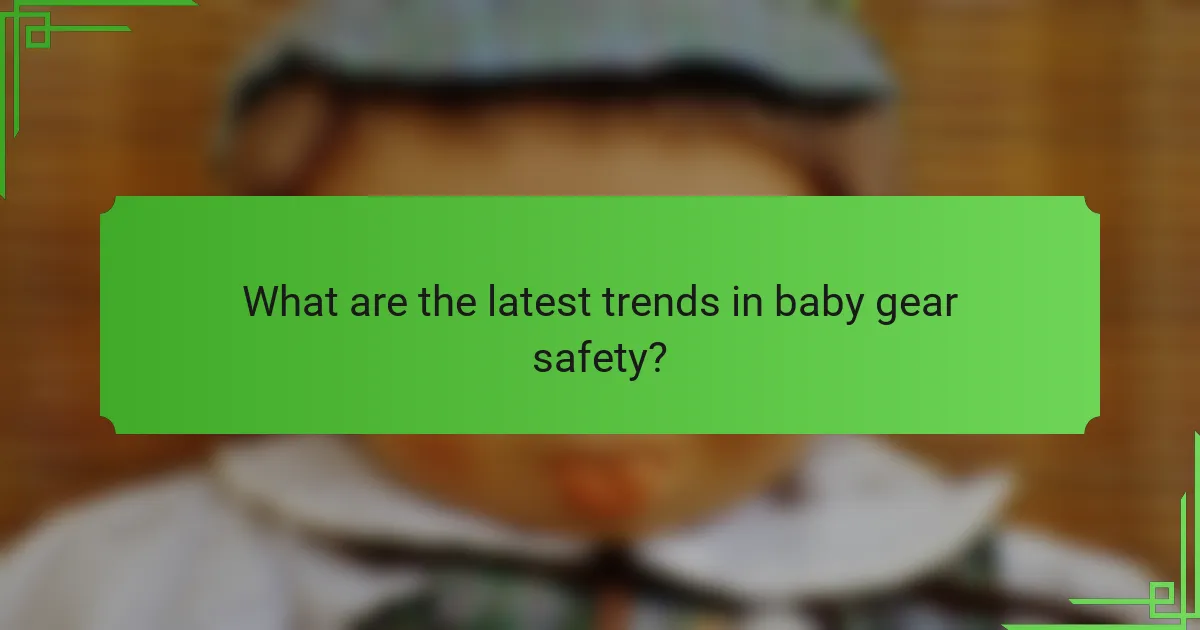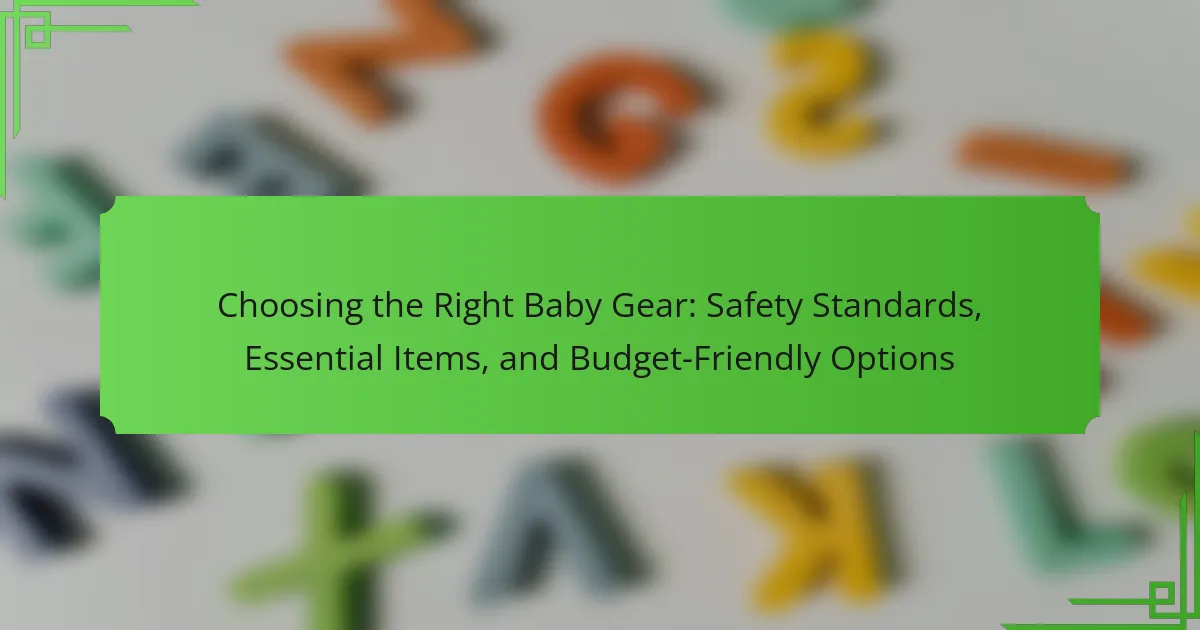Choosing the right baby gear involves careful consideration of safety, functionality, and budget. Safety is the top priority, with products needing to meet the standards set by the Consumer Product Safety Commission. Functionality encompasses ease of use and adaptability to a family’s lifestyle, while budget constraints necessitate prioritizing essential items. Recent trends highlight the integration of advanced safety features and smart technology in baby products, ensuring enhanced protection and convenience. As manufacturers innovate to meet evolving safety standards, parents are encouraged to select gear that is versatile and designed for longevity, ensuring it can adapt to their child’s growth and developmental needs.

What should you consider when choosing baby gear?
When choosing baby gear, consider safety, functionality, and budget. Safety is paramount; products should meet safety standards set by organizations like the Consumer Product Safety Commission. Functionality includes ease of use, portability, and adaptability to your lifestyle. Budget is important as baby gear can be expensive; prioritize essential items first. Additionally, check for product reviews and recommendations to ensure quality and reliability.
How do safety standards impact your baby gear choices?
Safety standards significantly influence baby gear choices by ensuring products meet minimum safety requirements. Parents prioritize gear that complies with established safety regulations. Compliance reduces the risk of injury or harm to infants. For instance, baby cribs must meet standards set by the Consumer Product Safety Commission (CPSC). These standards include specifications for slat spacing and mattress support. Products that fail to meet these standards are often recalled. Research shows that adherence to safety standards can decrease incidents of accidents by up to 50%. Therefore, parents are more likely to select gear from reputable brands that guarantee compliance with safety standards.
What are the key safety standards for baby gear?
Key safety standards for baby gear include compliance with ASTM International standards, which cover various types of products. These standards ensure that items like cribs, strollers, and high chairs meet safety requirements. For instance, cribs must adhere to the Consumer Product Safety Commission (CPSC) regulations, which prohibit drop-side designs and specify slat spacing. Strollers are required to have safety harnesses and brakes to prevent accidents. Additionally, baby gear should be free from harmful chemicals, adhering to regulations like CPSIA, which limits lead and phthalates. Regular testing by manufacturers ensures ongoing compliance with these standards.
How can you verify if baby gear meets safety standards?
To verify if baby gear meets safety standards, check for certification labels. Look for labels from organizations like the Consumer Product Safety Commission (CPSC) or ASTM International. These labels indicate compliance with established safety regulations. Review the manufacturer’s website for specific safety information and testing results. Research recalls on the CPSC website to ensure the product has not been flagged for safety issues. Additionally, read consumer reviews for real-world safety experiences. Understanding these factors helps ensure that the baby gear is safe for use.
What are the essential items for new parents?
Essential items for new parents include a crib, car seat, stroller, diapers, and baby clothes. A crib provides a safe sleeping space for the baby. A car seat is necessary for safe transportation. A stroller aids in carrying the baby while on the go. Diapers are essential for maintaining hygiene. Baby clothes are needed for warmth and comfort. These items are widely recommended by parenting experts and organizations.
What types of baby gear are considered essential?
Essential baby gear includes items like cribs, strollers, car seats, and baby carriers. Cribs provide a safe sleeping environment for infants. Strollers offer convenience for transporting babies. Car seats are crucial for ensuring safety during travel. Baby carriers allow parents to keep their hands free while holding their child. Other essential items include diapers, baby wipes, and clothing. These items are fundamental for daily care and safety. According to the American Academy of Pediatrics, these gear types are necessary for the well-being of infants and toddlers.
How do you prioritize which baby gear to buy first?
Prioritize baby gear by focusing on essential items first. Start with safety-related products such as a crib, car seat, and stroller. These items are crucial for the baby’s well-being and compliance with safety standards. Next, consider items that support daily care, like diapers, wipes, and clothing. Budget-friendly options can also be prioritized by researching second-hand items or sales. According to the American Academy of Pediatrics, a safe sleep environment is vital for infants, reinforcing the importance of selecting a crib early.
What budget-friendly options are available for baby gear?
Budget-friendly options for baby gear include second-hand items, budget brands, and multi-functional products. Second-hand items can be found at thrift stores or online marketplaces. They often come at a fraction of the retail price. Budget brands offer essential baby gear without compromising on safety. Brands like Graco and Chicco provide reliable products at lower price points. Multi-functional products, such as 3-in-1 car seats, save money by serving multiple purposes. According to consumer reports, these options can help parents save up to 50% on baby gear expenses. Choosing these alternatives allows parents to stay within budget while ensuring their baby’s needs are met.
How can you find affordable baby gear without compromising safety?
To find affordable baby gear without compromising safety, prioritize products that meet safety standards. Look for items certified by organizations like the Consumer Product Safety Commission (CPSC) or the American Academy of Pediatrics (AAP). Research brands known for quality and safety ratings. Utilize online resources and reviews to compare prices and features. Consider buying gently used items that have not been recalled. Join parenting groups for recommendations on budget-friendly options. Always check for recalls on products before purchasing. This approach ensures safety while managing costs effectively.
What are some tips for saving money on baby gear?
Buy second-hand baby gear to save money. Many items, such as cribs and strollers, are available in good condition. Check local thrift stores and online marketplaces. Consider borrowing items from friends or family. This can significantly reduce costs. Look for sales and discounts at major retailers. Websites often have clearance sections for baby gear. Utilize coupons and cash-back offers to maximize savings. Prioritize essential items over luxury brands. Focus on functionality and safety rather than brand names.
How can you ensure the baby gear you choose is safe and affordable?
To ensure the baby gear you choose is safe and affordable, research safety standards and certifications. Look for products that meet or exceed safety regulations set by organizations like the Consumer Product Safety Commission (CPSC). Check for recalls on baby gear through official websites. Compare prices across multiple retailers to find the best deals. Consider purchasing gently used items from reputable sources to save money. Read customer reviews to gauge the quality and safety of the gear. Prioritize essential items that serve multiple purposes to maximize value. Always verify the warranty and return policy before purchasing.

What are the latest trends in baby gear safety?
The latest trends in baby gear safety focus on enhanced safety features and smart technology integration. Manufacturers are increasingly incorporating advanced safety mechanisms, such as adjustable harness systems and impact-absorbing materials. These features aim to reduce injury risks during accidents.
Smart technology is also gaining traction. Devices now include alerts for unsafe conditions, like temperature extremes or improper installation. Additionally, many baby products are being designed with sustainable materials that meet safety standards.
Regulatory bodies are updating safety standards to reflect new research findings. The Consumer Product Safety Commission (CPSC) emphasizes rigorous testing for baby gear. This ensures products are safe and reliable for consumers.
Recent studies reveal that 80% of parents prioritize safety features when purchasing baby gear. This trend drives manufacturers to innovate continuously. The focus remains on creating safer environments for infants and toddlers.
How have safety standards evolved in recent years?
Safety standards for baby gear have significantly evolved in recent years. Regulatory bodies have introduced stricter guidelines to enhance child safety. For example, the Consumer Product Safety Commission (CPSC) updated standards for cribs in 2011. These updates eliminated drop-side cribs, which posed risks of entrapment. Additionally, new testing protocols for strollers have been implemented to ensure stability and durability. In 2020, the ASTM International introduced new standards for infant carriers, focusing on crash testing and safety harness performance. These advancements reflect a growing commitment to protecting children from potential hazards associated with baby products.
What innovations are improving baby gear safety?
Innovations improving baby gear safety include advanced materials, smart technology, and enhanced design features. Advanced materials, such as impact-absorbing foam, reduce injury risk during accidents. Smart technology, like sensors in car seats, alerts caregivers to unsafe conditions. Enhanced design features include adjustable harness systems that ensure a secure fit for growing infants. Furthermore, rigorous testing standards have increased in recent years, ensuring that products meet higher safety benchmarks. These innovations collectively contribute to a safer environment for infants and toddlers.
How do consumer preferences influence baby gear safety standards?
Consumer preferences significantly influence baby gear safety standards. Manufacturers closely monitor consumer feedback and trends. When parents prioritize safety features, companies adapt their designs accordingly. For example, increased demand for harness systems has led to stricter testing protocols. Additionally, consumer advocacy groups often push for higher safety standards. This pressure results in regulatory changes that enhance product safety. Historical data shows that recalls often follow consumer complaints about safety issues. As a result, consumer preferences directly shape the evolution of safety standards in baby gear.
What role do reviews and ratings play in choosing baby gear?
Reviews and ratings significantly influence the selection of baby gear. Parents often rely on the experiences of others to assess product quality. High ratings typically indicate satisfaction and reliability. Reviews provide insights into safety, usability, and durability. Research shows that 70% of consumers trust online reviews as much as personal recommendations. Ratings help parents compare similar products easily. Negative reviews can highlight potential risks or issues. Overall, reviews and ratings serve as a vital decision-making tool in the purchasing process for baby gear.
How can you interpret safety ratings for baby gear?
Safety ratings for baby gear indicate how well products meet established safety standards. These ratings are often provided by independent testing organizations. Look for certifications from recognized bodies like ASTM International or Consumer Product Safety Commission. Higher ratings typically reflect better safety features and performance in crash tests or hazard assessments. Check for specific labels that indicate compliance with safety regulations. Additionally, read reviews and research the product’s safety history. Understanding these ratings helps parents make informed choices for their child’s safety.
What are common red flags in baby gear reviews?
Common red flags in baby gear reviews include vague language and lack of detail. Reviews that do not specify the product’s features can indicate a lack of genuine experience. Overly positive reviews without any criticism may suggest bias or inauthenticity. A lack of verified purchases can also raise concerns about the review’s credibility. Reviews that focus on aesthetics rather than safety features can be misleading. Additionally, inconsistent ratings across platforms may indicate manipulation. Finally, failure to mention safety certifications can be a critical oversight. These factors can help parents identify potentially unreliable products.
What are the most common mistakes to avoid when selecting baby gear?
Common mistakes to avoid when selecting baby gear include overlooking safety standards, choosing items based on trends rather than functionality, and failing to consider the baby’s age and size. Many parents prioritize aesthetics over safety features. This can lead to purchasing items that do not meet safety regulations. Additionally, buying second-hand gear without checking for recalls is a significant risk. Not testing the gear for ease of use can also lead to frustration. Parents often underestimate the importance of comfort for both the baby and themselves. Lastly, neglecting to account for storage space can result in clutter.

How can you choose baby gear that grows with your child?
Choose baby gear designed for adaptability and longevity. Look for items with adjustable features, such as height or weight limits. Select convertible products, like cribs that transform into toddler beds. Ensure the gear meets safety standards for all stages of growth. Research brands known for durable and versatile products. Check user reviews for insights on longevity and usability. Prioritize gear that can be used in multiple ways, such as car seats that convert from rear-facing to forward-facing. This approach ensures that your investment lasts through various developmental stages.
What features should you look for in versatile baby gear?
Versatile baby gear should have multiple functionalities to adapt to various needs. Look for items that can transform from one use to another, such as a stroller that converts to a car seat. Lightweight and easy-to-fold designs enhance portability, making transitions smoother. Durability is crucial; gear should withstand daily wear and tear. Safety features, like harnesses and sturdy construction, ensure the child’s protection. Additionally, ease of cleaning is important; machine-washable fabrics can save time. Check for adjustable components, which allow for customization as the child grows. Finally, consider storage options; ample space for essentials can enhance convenience during outings.
How can multi-functional baby gear save you money?
Multi-functional baby gear can save you money by reducing the need to purchase multiple items. For example, a convertible crib can transform into a toddler bed, eliminating the need for a separate purchase. This versatility allows parents to invest in fewer products while meeting various needs as the child grows. Additionally, multi-functional gear often has a longer lifespan, providing value over time. According to a study by the American Academy of Pediatrics, parents can save up to 30% on baby gear costs by choosing items that serve multiple purposes. This financial efficiency helps families manage budgets more effectively while still ensuring their child’s safety and comfort.
What are the benefits of choosing adjustable baby gear?
Adjustable baby gear offers versatility and longevity. It can adapt to a growing child’s needs. For example, adjustable cribs can transform from a crib to a toddler bed. This extends the product’s usable life, reducing the need for frequent replacements. Adjustable strollers can accommodate different seating positions and sizes. They provide comfort and support for infants and toddlers alike. Moreover, adjustable baby gear often promotes better ergonomics for parents. This can enhance usability and ease of handling. Overall, choosing adjustable baby gear is a cost-effective and practical solution for families.
What resources are available for researching baby gear?
Online parenting forums provide valuable insights and reviews on baby gear. Websites like What to Expect and BabyCenter offer expert advice and user-generated content. Consumer Reports evaluates safety ratings and performance of various baby products. Retailer websites often feature customer reviews and product comparisons. Additionally, social media groups dedicated to parenting can be useful for firsthand experiences. Local libraries may have books and magazines focused on baby gear. Parenting blogs frequently share personal recommendations and tips. These resources collectively help parents make informed decisions about baby gear.
How can online communities assist in choosing baby gear?
Online communities assist in choosing baby gear by providing shared experiences and recommendations. Parents can post questions about specific products. Other members can respond with personal insights and reviews. This feedback often includes safety ratings and usability tips. Many online groups have experienced parents who share what worked for them. Research indicates that peer recommendations significantly influence purchasing decisions. A survey by the Pew Research Center found that 70% of parents rely on online advice when selecting baby products. These communities also discuss budget-friendly options and sales. This collective knowledge helps new parents make informed choices.
What are the best websites for baby gear comparisons?
The best websites for baby gear comparisons include What to Expect, BabyGearLab, and The Bump. What to Expect offers comprehensive reviews and comparisons based on user feedback. BabyGearLab provides in-depth testing and analysis of various baby products. The Bump features expert advice and user reviews to guide parents in their choices. Each of these sites is recognized for its reliability and thoroughness in evaluating baby gear.
What practical tips can help you make informed decisions about baby gear?
Research baby gear safety standards before purchasing. Look for products that meet or exceed safety regulations. Check for recalls on items you are considering. Read reviews from other parents to gauge product reliability. Compare prices across different retailers to find the best deals. Prioritize essential items that fit your lifestyle and budget. Consider the longevity and versatility of products. Test items in-store when possible to ensure comfort and ease of use.
Choosing the Right Baby Gear is centered around the essential considerations for parents when selecting baby products, focusing on safety standards, key items, and budget-friendly options. The article highlights the importance of adhering to safety regulations set by organizations like the Consumer Product Safety Commission and outlines essential gear such as cribs, car seats, and strollers. It emphasizes the significance of researching product reviews, understanding safety certifications, and prioritizing essential items based on functionality and budget. Additionally, the article discusses innovative trends in baby gear safety and offers practical tips for making informed purchasing decisions.
